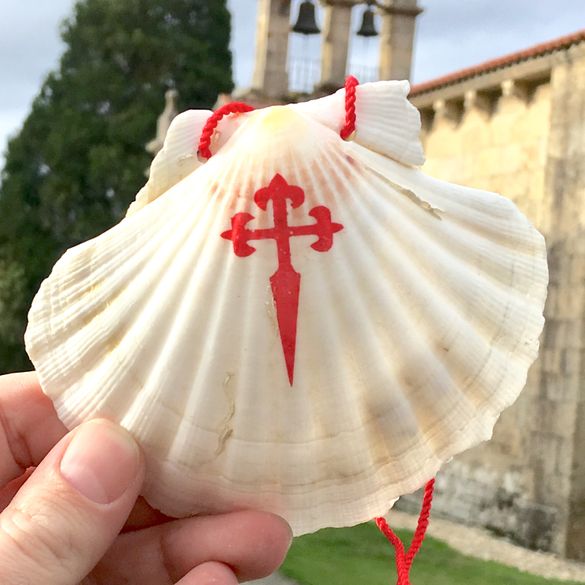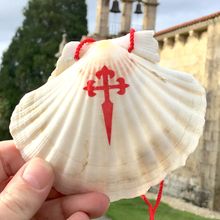 19 Nov 2021
19 Nov 2021
Camino Inglés, the original Camino for British and Irish pilgrims dating back to the Middle Ages, is responding to the increased interest in slow travel by adding a new option that allows travellers to complete the route in shorter stages and at a slower, quieter pace.
The 'slow travel' approach places a greater emphasis on establishing a greater connection with the region you visit (or travel through) and the local people, history, culture and even gastronomy.
Despite its rising popularity, Camino Inglés remains less busy, less trodden and less commercialised compared to other Camino routes – and this new SLOW option gives pilgrims the opportunity to connect further spiritually with their journey.
The SLOW Camino Inglés itinerary proposes shortening the distance walked each day to cover between an average of 12-15 km per stage, if not less; in comparison, some sections of the Camino Inglés can be up to 24 km.
As they follow in the footsteps of their ancestor pilgrims and cross paths and bridges that go back hundreds of years, travellers have more opportunities to reflect on the route's history, appreciate the spectacular scenery and visit sites and monuments that otherwise would be easier to miss. Whether they want to spend some extra time at Betanzos to sample some of the mouth-watering Spanish tortillas that the town is famous for, slow down as they enter the Enchanted Forest to take in the peaceful atmosphere or enjoy a refreshing dip in the sea or a river in the summer, the slower pace allows to experience 'more' of the Camino Inglés.
Similar to the primary Camino Inglés route, the new SLOW option also has two starting points; normally covered in either six (the route from Ferrol) or four (the route from A Coruña) days, the new SLOW itineraries take nine and five days respectively to complete:
Ferrol to Santiago de Compostela – SLOW Camino Inglés stages (9 days):
1. Ferrol – Neda (15.4 km); 2. Neda – Pontedeume (12.9 km); 3. Pontedeume – Miño (9.2 km); 4. Miño – Betanzos (10.7 km); 5. Betanzos – Presedo (13.5 km); 6. Presedo – Bruma (10.6 km); 7. Bruma – Poulo (12 km); 8. Poulo – Sigüeiro (12.2 km); 9. Sigüeiro – Santiago de Compostela (16.5 km)
A Coruña to Santiago de Compostela – SLOW Camino Inglés stages (5 days):
1. A Coruña – Sergude (20 km); 2. Sergude – Bruma (13 km); 3. Bruma – Poulo (12 km); 4. Poulo – Sigüeiro (12.2 km); 5. Sigüeiro – Santiago de Compostela (16.5 km)
Pilgrims can find more information on each of these stages on the new Camino Inglés website, which aims to help visitors find all the essential information they will need to plan and prepare the best way possible and get the most out of their Camino experience.
Manuel Mirás, President of the Association of Councils on the Camino Inglés, said:
“The SLOW Camino Inglés is an opportunity to get under the skin of the towns and villages you pass through as a 'peregrino' on your way to the city of Santiago. It is a slower, quieter and more enjoyable way to walk and creates a deeper spiritual and emotional impact that will not only be 'in passing' but will make the experience even more meaningful.”
Councillor Antolio Leira, from the A Coruña Province Council, said:
“Walking the Camino Inglés in shorter stages gives travellers the chance to enjoy every step of the route at their own pace and develop a deeper connection with the places they go through. As they take their time to complete each stage, they will be able to take in more of the scenery, the landscapes, the history and the heritage that form part of their Camino journey.”
The Camino Inglés route traces the paths that pilgrims from Britain and Ireland would follow on foot in the Middles Ages after reaching northwestern Spain by boat and on their journey to the city of Santiago de Compostela; the route has two starting points in the Galicia region, Ferrol and A Coruña, and runs entirely through the province of A Coruña.
For more information on Camino Inglés and the new SLOW option please visit https://www.caminoingles.gal/en/
- Ends -
NOTES FOR EDITORS:
About the A Coruña Province Council:
The A Coruña Province Council has been working with organisations across Britain and Ireland since 2016 to promote the Camino Inglés route. Camino Inglés runs entirely through the province and the council's work focuses on recovering and communicating the significance and heritage of the trail to both locals and visitors. With Durham marking the start of the Camino path in England, it has worked closely with organisations such as Visit County Durham, the Durham County Council and the University of Durham to support the creation of the local association of Friends of Finchale Camino Inglés; assist with the waymarking of the trail; plan the first organised pilgrimage since the 16th century; and coordinate talks and school exchange programmes. More recent initiatives include reinforcing the links with St James´ Way, from Reading to Southampton, and St Michael´s Way in Cornwall, both of which are affiliated with Camino Inglés. In Ireland, it is working with local groups and the Camino Society, the Dublin-based voluntary association for the Camino de Santiago; there currently are nine different pilgrimage routes that you can walk in Ireland, with more in the process of applying.
About the Association of Councils on the Camino Inglés:
Founded in 2019 and endorsed by the A Coruña Province Council, the Association of Councils on the Camino Inglés is a not-for-profit organisation, with 16 city and town council members: Ferrol; Narón; Neda; Fene; Cabanas; Pontedeume; Miño; Paderne; Betanzos; Abegondo; A Coruña; Carral; Mesía; Ordes; Oroso; and Santiago de Compostela. It was conceived to facilitate the collaboration between the various authorities, municipalities and associations that can be found along the Camino Inglés; promote the province´s exceptional nature, history, heritage, art and culture; plan and implement initiatives for the sustainable development of the route; streamline the tourist promotion channels and messaging; and support the local businesses.
PR CONTACT:
For more media information, images and interview requests please contact:
Tom Panagos – travelpress@u-mining.com


